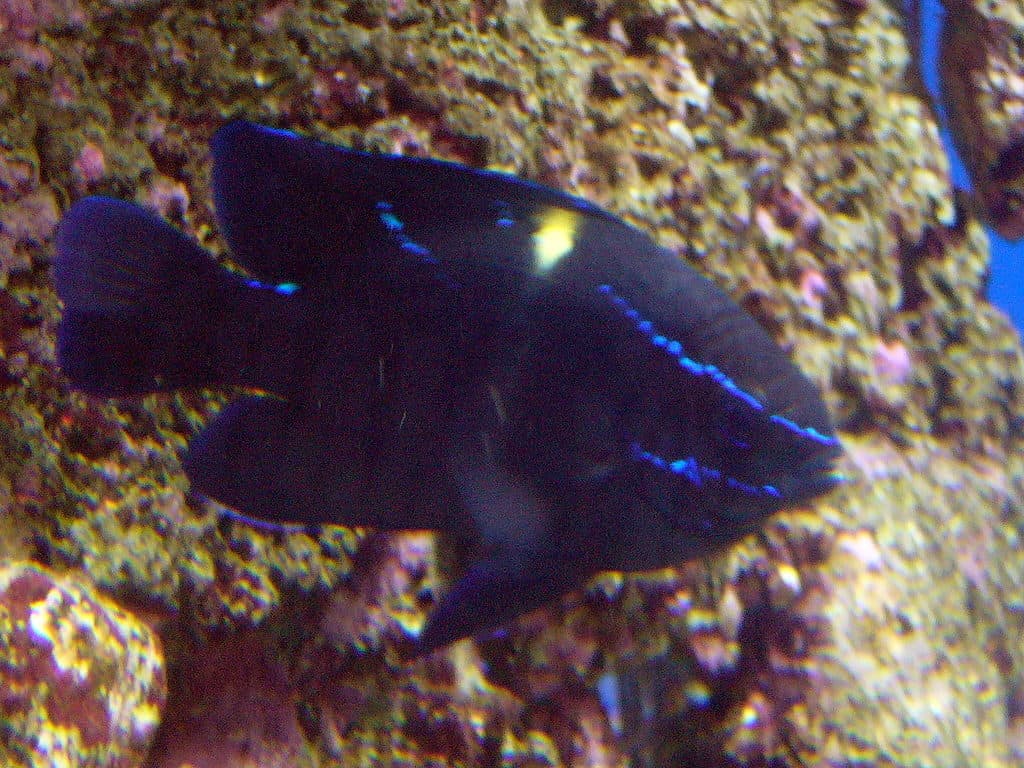Damselfish have gotten a bad reputaiton over the last few decades but like anything in life, paying careful attention to the right types of Damselfish and meeting their needs will ensure you do not add an aggressive Damselfish to your aquarium and instantly regret it!
The aggression shown by Damselfish is to protect their territory. If they are added to an aquarium first they will claim the whole tank as their territory and bully any other fish added after. By adding Damselfish last you can ensure they remain calmer and only have a small territory to protect.
Today we are looking into why damselfish are aggressive, which ones to avoid, which ones are tolerable, and how you can prevent them from getting aggressive.
Damselfish come from the family Pomacentridae and include over 300 species, with some able to live in brackish water conditions. They come in a variety of striking colours, sizes, temperaments and are extremely hardy making them great for the novice aquarium hobbyist. – So why do they get a bad name?
If you ask aquarium hobbyists about Damselfish, some may say they are super aggressive, will target their tank mates, batter them to death, and that they will even try to take a chunk out of your hand if they get the chance. However, if you introduce them correctly, select the right ones, and are wise when it comes to compatibility, these fish can make great additions to your aquarium.
Why Are Damselfish Aggressive?
By their nature, Damselfish are pretty territorial fish and are not shy about warding off any potential threats to that territory. They are very fast, maneuverable swimmers, their small size allows them to easily dart in and out of holes and cracks and they seem to have an endless amount of energy and determination when it comes to holding their ground.
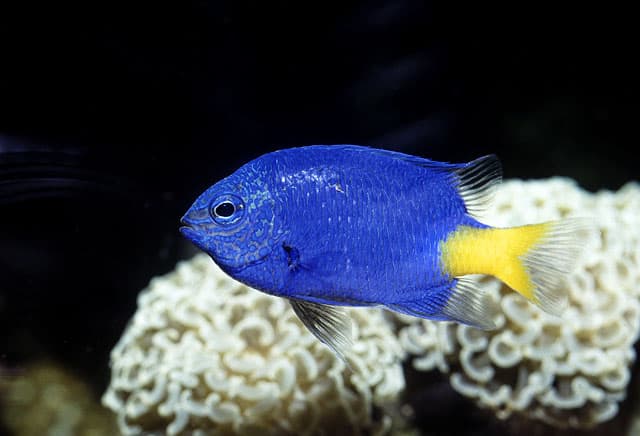
The problem that many newcomers to the hobby seem to end up with is that they add the Damselfish to their aquarium first. They are beautifully colored, always swimming around, and cheap to buy. Because of this, they end up being the first fish purchase for many. This is where the problems begin.
When a Damselfish is the first fish introduced to an aquarium it will take that whole tank as its territory – and why not! It/they are the only fish in there. Once you begin to add any more fish they will be seen to be encroaching on the territory of the Damselfish and it/they will bully the new additions, usually to death.
This is heartbreaking for the new aquarium owner, so what do they do? They go and buy more fish and usually end up with the same outcome. Until that/those Damselfish are removed, most new additions will be bullied to death. This is not good, and this is why Damselfish get such a bad reputation.
Why Should Damselfish Not Be Used For Tank Cycling?
Because Damselfish are identified as hardy fish, people used these fish to cycle their tanks. The fish would eat and defecate creating an ammonia source for the nitrifying bacteria to consume and multiply on. Damselfish seem like a great choice for tank cycling as they are known to tolerate higher levels of ammonia, nitrite, and nitrates than regular saltwater fish, and even today many people still use them to cycle their tank.
But we are now living in 2021, and no one should be using Damselfish to cycle their tank or any other live fish for that matter! There are much better, faster, and easier ways to get your tank going.
See the ‘Further Reading’ section at the end of this article for more info.
Not only is it inhumane to use live fish to cycle your tank, as you do not know the potential harm the water conditions of a cycling tank can do, but Damselfish are one of the hardest fish to catch after the cycling process has finished, and believe me, if you have added a Damselfish to your tank before any other fish, you will be wanting to catch and remove them!
How Do You Safely Introduce Damselfish Into An Aquarium?
If you do opt for Damselfish, make sure you introduce them last as they will be the most aggressive out of the bunch. This will allow the other fish to have already claimed their territory – which prevents Damselfish from being the ‘Boss’ and ‘Alpha Fish’ in the aquarium.
If Damselfish are a ‘Must Have’ on your fish stocking list, then keep semi-aggressive fish that will not be bullied by Damsels. No one likes to be picked on, and at least if the other fish in your aquarium are semi-aggressive, they can stand up for themselves! – This will also reduce the chances of your fish being bullied or killed by the Damsels.
Here are some examples of Damsel-compatible tank mates, just be sure to add these fish first!
- Dwarf Angelfish
- Tangs
- Dottybacks
- Clownfish – these are actually related to Damselfish
- Bottom Dwelling Gobies
What Habitat and Tank Requirements Do Damselfish Need?
Firstly, you want to make their transition into a new habitat as smoothly as possible. Have you ever moved to a new house, and remembered how stressful it was? Your fishy friends feel the same way! Any increased stress can lead to enhanced aggressive behavior – making them very unfriendly to their new neighbors.
If you have a fish-only aquarium, you will want to have lots of rock formations so that vulnerable fish can hide, this will also allow the Damsels to claim a small area of the tank without upsetting other residents.
- If you are planning on keeping just one small Damsel, a 30-gallon tank would provide enough space for them to dart around
- If you are going to buy a couple, you will need 50 gallons
- For 4 or more, you will need a tank that holds at least 100 gallons
The recommendations above will allow plenty of space for all your fish otherwise Damselfish can turn aggressive and very territorial. In small tanks, one Damsel can claim the whole aquarium, this is why it is so important that they be the last addition to your tank!
Are There Any Damselfish to Avoid as a Beginner?
Blue or Neon Velvet Damselfish
Paraglyohidodon oxyodon
- Care Level: Easy
- Temperament: Aggressive
- Max. Size: 6”
- Diet: Omnivore
- Reef Compatible: Yes
- Min. Tank Size: 30 Gallons
The Blue or Neon Velvet Damselfish can grow fairly big. Don’t be fooled by their beautiful neon blue stripes, when they reach adult age, they lose this magnificent coloration and turn completely black, and usually become quite the bully!
This is one fish you may regret adding!
Three Spot Domino Damselfish
Dascyllus trimaculatus
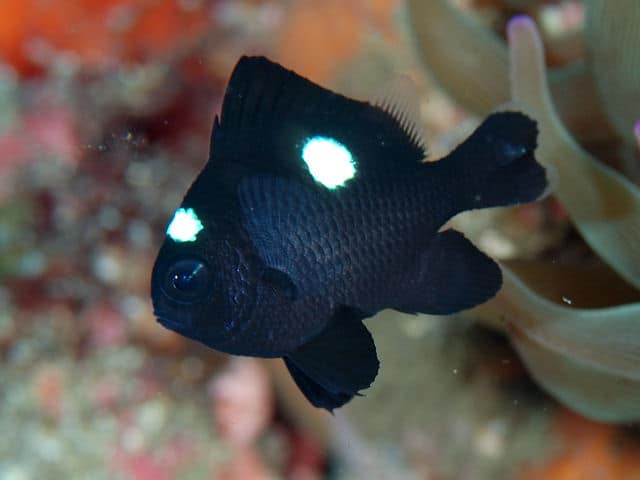
- Care Level: Easy
- Temperament: Semi-aggressive
- Max. Size: 5 ½”
- Diet: Omnivore
- Reef Compatible: Yes
- Min. Tank Size: 30 Gallons
The Three Spot Domino Damsel is another fish that seem very tempting in the local fish store. These can also grow quite big and fit the typical ‘mean’ Damsel reputation.
If you have a carpet anemone it will claim this as its territory immediately.
Blue Devil Damselfish
Chrysiptera cyanea
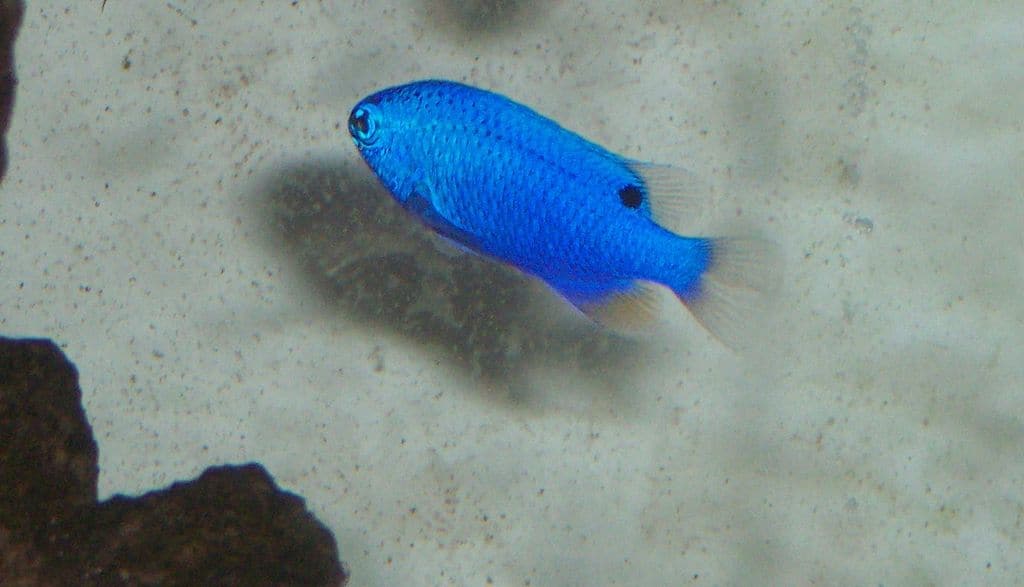
- Care Level: Easy
- Temperament: Aggressive
- Max. Size: 3”
- Diet: Omnivore
- Reef Compatible: Yes
- Min. Tank Size: 30 Gallons
As the name suggests these really are the devil! The Blue Devil Damselfish are highly aggressive and are even known to bite your hand if you put it in the tank!
They are highly territorial and very fast fish making them very difficult to remove. If you add one of these to your tank you will pretty much have to empty your entire tank to catch it!
Four Stripe Damsel
Dascyllus melanurus
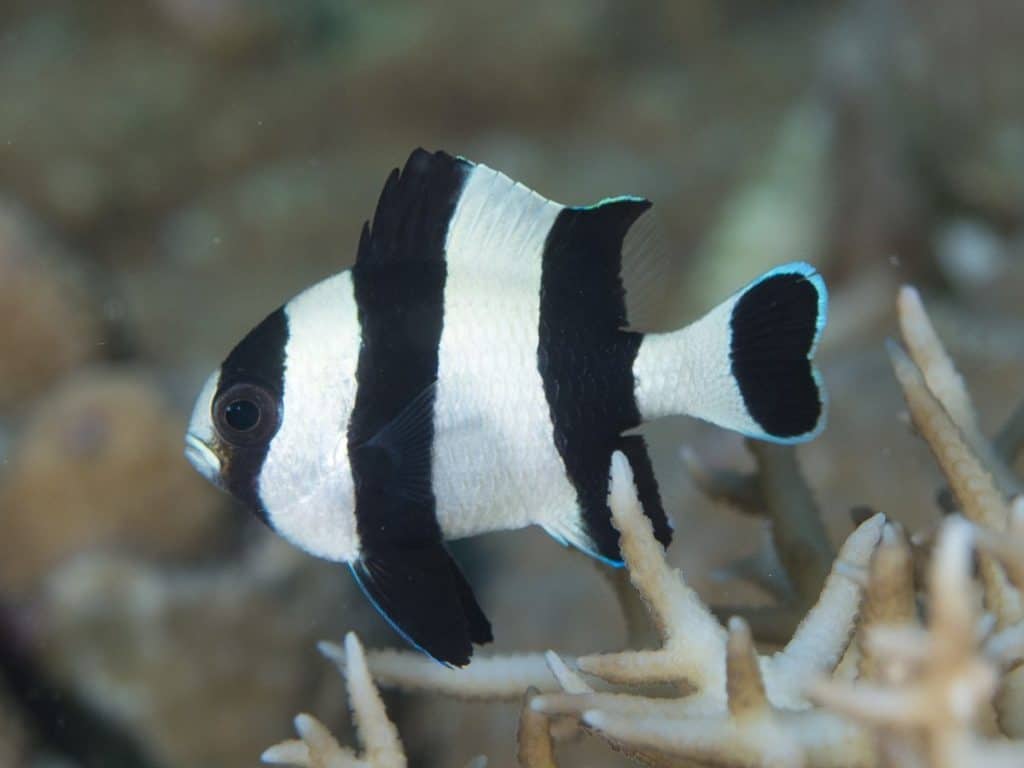
- Care Level: Easy
- Temperament: Aggressive
- Max. Size: 3 ¼”
- Diet: Omnivore
- Reef Compatible: Yes
- Min. Tank Size: 30 Gallons
Also known as the Blacktail Dascyllus, Blacktail Damsel or the Blacktail Humbug Damselfish.
Even though these fish will stay relatively small their aggression does not match!, They can be aggressive towards other fish and even bigger fish than them.
They are best kept in a predator or aggressive fish aquarium.
Are There Any Damselfish To Recommend For a Beginner?
So, you are probably thinking why would I want Damselfish in my aquarium? – Well, they are not all bad, plus you will not find many other strikingly blue-colored saltwater fish out there that stay small! When you get the right ones and add them at the right time they can be model citizens! The two that I recommend below are the ONLY Damselfish that I own and advise others to get if they want success with keeping Damsels.
So, why Damsels?
- They are super hardy fish
- They are not fussy eaters
- Their blue coloration is unique
- They are small so do not require a huge aquarium
- If you introduce them correctly, they can be reef safe!
Below are my favorite Chrysiperta Damselfish that are friendlier and worth checking out! – They have beautiful colorations like other Damselfish but will bring a lively nature to your aquarium whilst being more peaceful.
Azure Damselfish
Chrysiptera hemicyanea
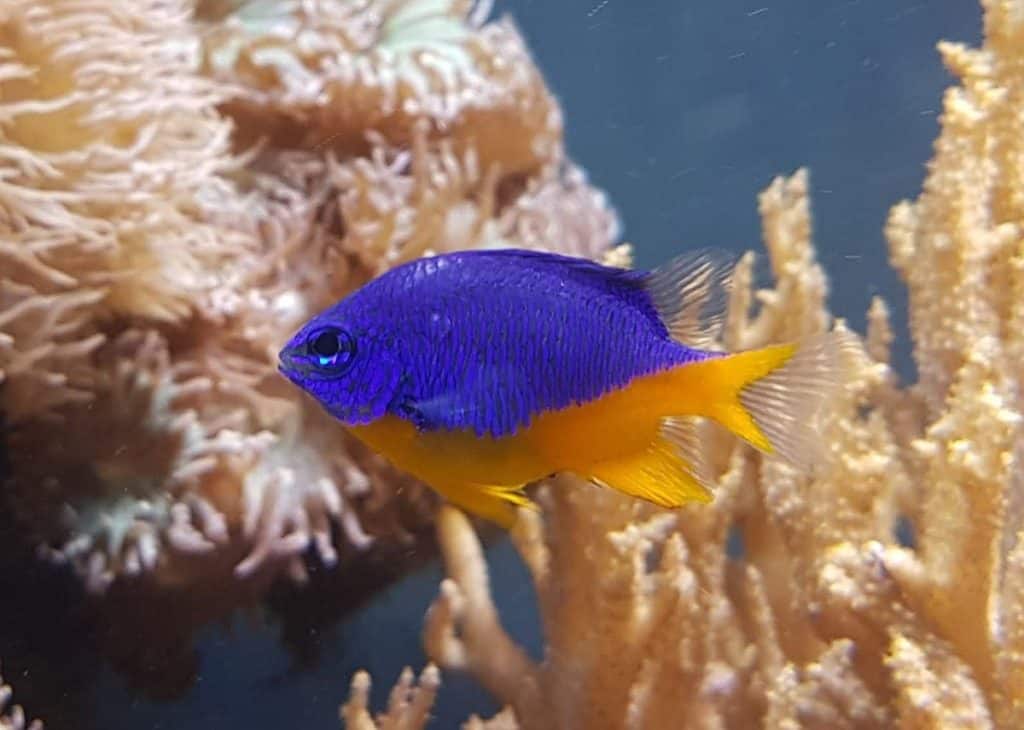
- Care Level: Easy
- Temperament: Semi-aggressive
- Max. Size: 2 ¾”
- Diet: Omnivore
- Reef Compatible: Yes
- Min. Tank Size: 30 Gallons
If you are looking for a great, semi-docile Damselfish, then these are the best of the bunch! The Azure Damselfish has the striking blue we all crave from the Damsels, coupled with a bright yellow belly that really contrasts!
These are fairly well-mannered and are less likely to pick a fight than other fish. I love my pair of Azures!
Talbot’s Damselfish
Chrysiptera talboti
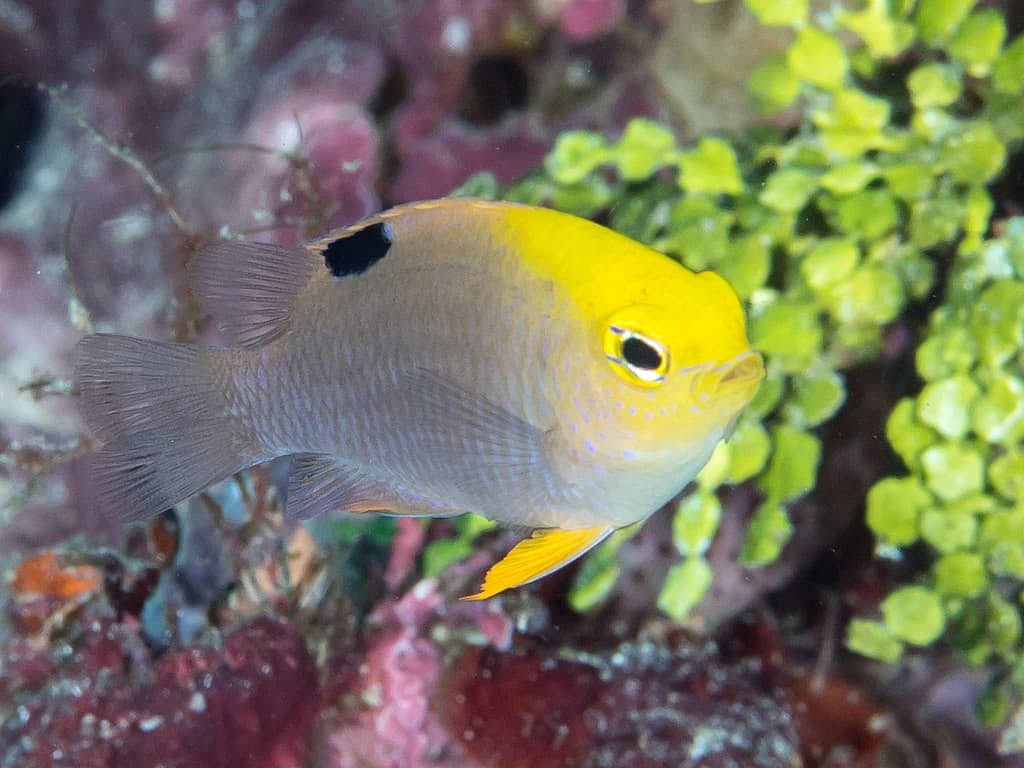
- Care Level: Easy
- Temperament: Semi-aggressive
- Max. Size: 2 ¼”
- Diet: Omnivore
- Reef Compatible: Yes
- Min. Tank Size: 30 Gallons
One of the most peaceful Damselfish you could get! My pair are model citizens and have never shown an ounce of aggression towards any other fish or invert!
These are not neon blue, but they make up for it with their striking yellow head and pelvic fin, and the black spot on their back.
To Finish
If you are wanting to add color to your aquarium then these two Damselfish could be the fish for you! Being hardy, beautiful, and the perfect size, they have become increasingly popular in the aquarium hobbyist world, but as always keep a close eye on the aquarium. If they start to become too aggressive towards other residents, you will need to consider removing them from the tank, so they do not fight to the death or make your other fish sick.
Damselfish are known for their beautiful coloration, aggressiveness, and territorial nature, but as long as you introduce them correctly into your aquarium and they have enough space you should be successful in keeping these striking fish. Damselfish are tough to catch so be sure to follow these guidelines in this article and you will not be tearing your hair out!
Further Reading
If you found this article helicopter I highly recommend the following:

